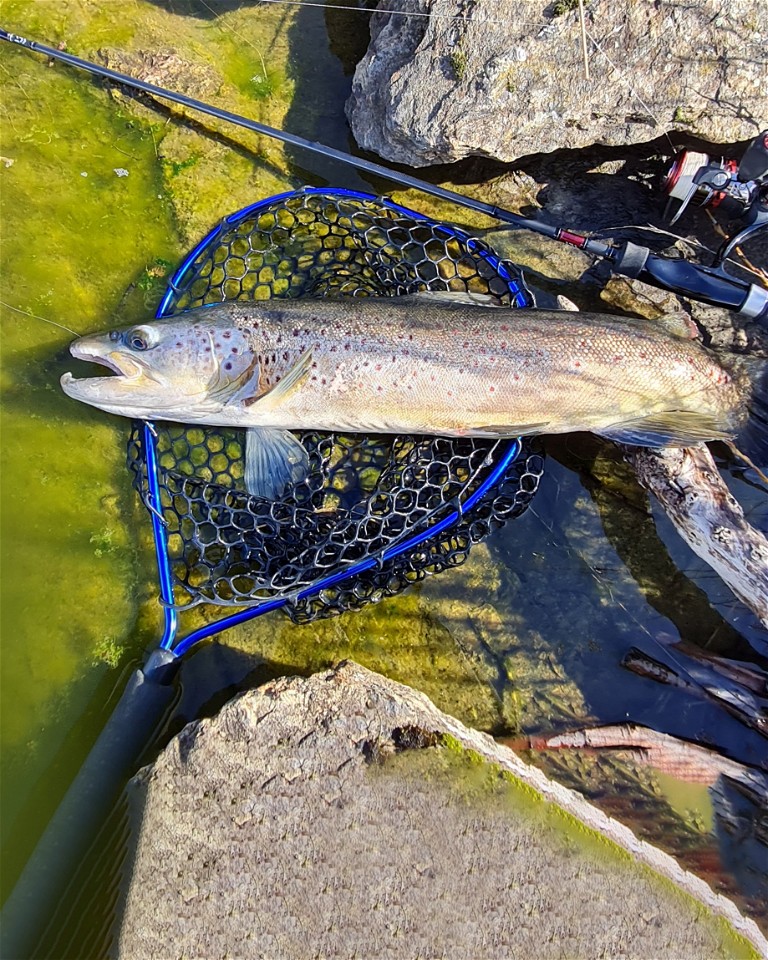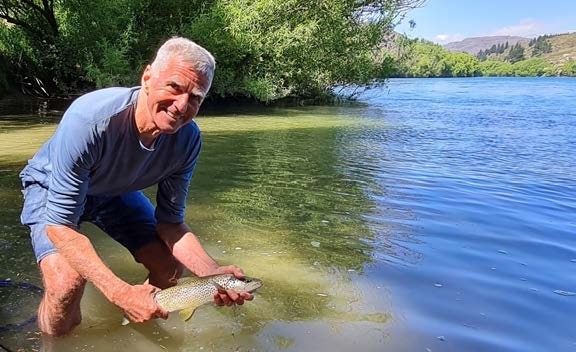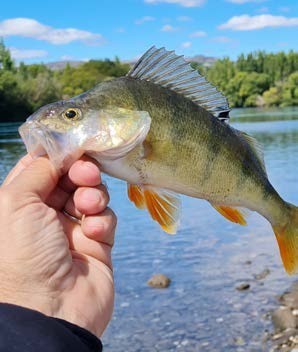INTENSE SOUTHERN SUMMER
By Greg Morton
Central Otago is a hot place in summer.
What’s worse is that the incredible intensity of the sun can cook or evaporate anything exposed to direct rays.
Throw in El Niño’s strong afternoon winds and the whole region turns brown and dry.
Such conditions are not good for trout that thrive in cold water, or anglers who burn easily. Trout suffer badly in poorly oxygenated heated water. My observation is that the best fishing this summer in my patch is in deep lakes, deep rivers, alpine reservoirs and deep canals.
The omens this summer were not good for shallow-water anglers like me. I first visited a local Alexandra irrigation reservoir called Conroys Dam which has mainly resident brown trout and some released rainbow trout. The trout feed on bully, koura, nymphs and terrestrial insects.
It is a rocky dam, and at the beginning of the trout season the submerged shoreline rocks are inhabited by lots of bully. The water is usually an amber-brown colour – not this visit, however. The water was murky and green, and the visibility was poor. Where I could see rocks, there were no bully flitting around. But I persevered. Tying on a Savage softbait, I began working my way along the shoreline. About an hour later I had a hard strike and found myself hooked up to a long brown trout jack.
In prime condition, he would have been a quality fish. Scarred and lean, he came quickly to the net. I lay him on it and quickly snapped a couple of photographs before releasing him. Warm water and a lack of bully would not be helping him recover from the distant spawning.
The Lower Manorburn Dam was the next fishing spot to check. I was disappointed to find it also green, hot and looking like pea soup. While kayaking, I dipped my hand in the water and it was a tepid bath. I suspected a toxic algae bloom so gave my hand a good wash from my water bottle as a precaution. No fish were caught.
Other places I like to fish locally have also fallen over like dominos to the heat. The following three have been identified as suffering from toxic algae blooms by the Otago Regional Council: Butchers Dam, the Manuherikia River, and Falls Dam. Toxic algae, or cyanobacteria, often appears when the weather is warm and river flows are low, so this problem could occur in these locations every year as the heat is not going away.
It is a serious problem and the deaths of three dogs after a Manuherikia River shoreline walk can probably be linked to drinking toxic water. Gutted fish are said to be safe to eat from toxic algae locations, but would you enjoy the meal? I wouldn’t. The problem has occurred in other provinces as well, and just recently Lake Hood near Ashburton turned toxic green.
Having crossed a lot of fishing places off the local list because of the algae, I focussed on the fast-flowing and deep waterway that flows below my house. The Clutha River (Mata Au) was still blue.
Fish that live in the section of the Clutha River between Clyde and the top of Lake Roxburgh consist of three species: brown trout (the dominant species), rainbow trout and perch. The average fish size is quite small in this section as the river here carries a lot of fine silt and moves very fast. Those I land are characterised by a lean, streamlined body and a powerful tail. They are small pocket rockets. Spawning rainbows or browns from Lake Roxburgh and willow grub-eating brown trout make up the occasional larger fish an angler might encounter.
The first Clutha River location I targeted was the mouth of the Fraser River. It oozes potential, but in my experience the trout landed here have been quite small. I can’t explain why, but a lack of food would have to rank high in the causes list. A few bigger rainbows are landed in winter. I used a small green Thunder Bug Mepps spinner and over a couple of hours landed three small brown trout. The next fish was different as it was only the second perch I have landed in this spot. He came home with me for dinner.
A few weeks later, my flyfishing brother John stayed with me while visiting horticulture clients. One morning his calendar was free, so we decided to fish a section of the Clutha that allowed me to spin fish and him to seek out willow grub-eating brown trout. Green is my favourite spinner colour for the Clutha, and because this new section was deeper I used a reflective green Panther Martin spinner. I initially landed one small brown and one small rainbow before landing a larger, barbequedestined brown trout.
John had been scouting while I had been spin fishing and had located two brown trout patrolling a pool overhung with willow trees. I joined him just before he made a play for the oblivious fish. It always looks to a spectator as though trout will be sitters when you spot them feeding on willow grubs. They cruise back and forth across the pool, checking out everything that looks like a fallen grub and rising regularly. The problems for the angler become apparent when they go to cast. There is long grass, trailing branches and tricky currents to navigate, and the fussy fish are always on the move.
Success occurred while he was lifting his grub fly for yet another cast when an unseen trout nailed the fly. The hard part had been achieved and the landing part was very straightforward – into the net, a quick photo and a careful release. It was good to see some spots have survived the heat.

A brown trout from Conroys Dam.

1) Success on the Clutha River – a willow grub-eating trout.

2) A Central Otago perch destined for the dinner table.

3) Numerous waterways were identified as suffering from toxic algae blooms by the Otago Regional Council this summer.